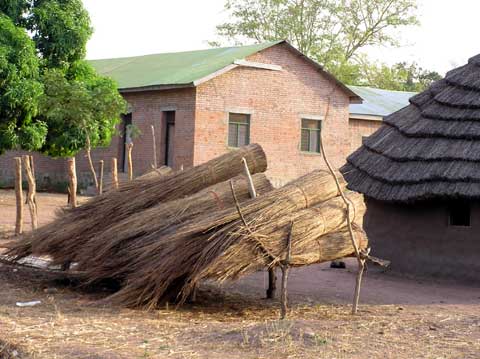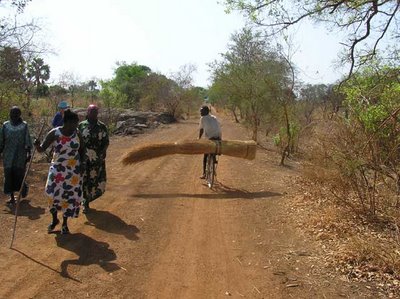I’ve talked before about how the people of Lui are hesitant to build or re-build with mud structures, opting to build of grass instead. Building in grass is faster, and less expensive.
These are some grass bundles, harvested and waiting for buyers.

 It was pretty fun to see this sight -- a guy riding along the road on his bicycle with grass bundles as cargo. But that also led me to wonder what's going on here. I would have thought that -- with these tall grasses so plentiful throughout Lui -- everyone would just go into the brush and cut his/her own grasses to make roofs or shelters. Not so! I do not understand the reason, but I gathered this information: Most people do not go out and cut their own grass. Instead, they have to buy it. And it is expensive, by Sudanese standards: something like $1US per bundle. And it takes something like 100 bundles to make a roof. So, in fact, the grass cutters are upper-end businessmen.
It was pretty fun to see this sight -- a guy riding along the road on his bicycle with grass bundles as cargo. But that also led me to wonder what's going on here. I would have thought that -- with these tall grasses so plentiful throughout Lui -- everyone would just go into the brush and cut his/her own grasses to make roofs or shelters. Not so! I do not understand the reason, but I gathered this information: Most people do not go out and cut their own grass. Instead, they have to buy it. And it is expensive, by Sudanese standards: something like $1US per bundle. And it takes something like 100 bundles to make a roof. So, in fact, the grass cutters are upper-end businessmen.My U.S. brain just overloads at that point. I do not understand how such a basic building material -- which is in such great supply in Lui -- can be so difficult for most people to afford. Maybe one of the next travelers to Lui can help me (and us) understand that dynamic.
 As we walked the road, we noticed that this is how clothes are dried. I never did see the process for washing clothes. But this is how they are dried all around Lui: draped over bamboo fences.
As we walked the road, we noticed that this is how clothes are dried. I never did see the process for washing clothes. But this is how they are dried all around Lui: draped over bamboo fences.




No comments:
Post a Comment